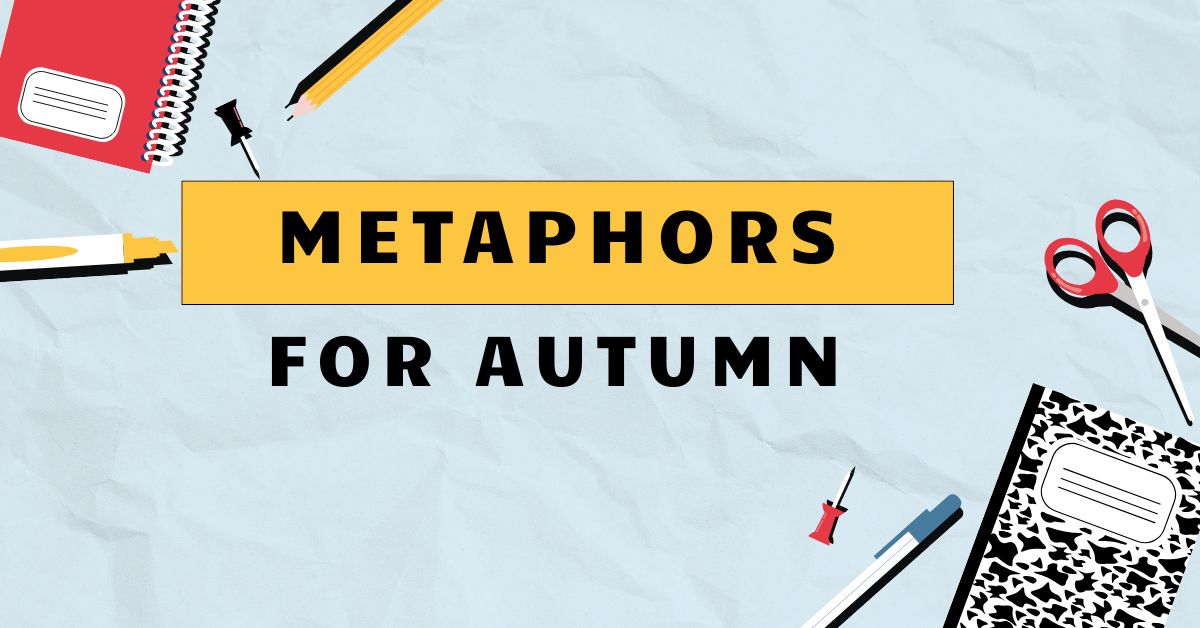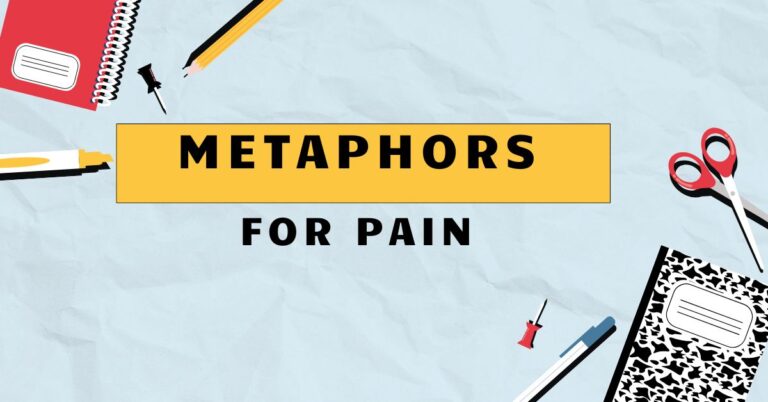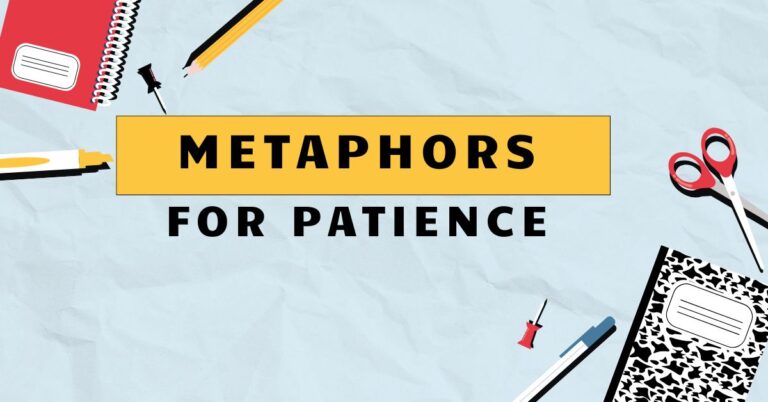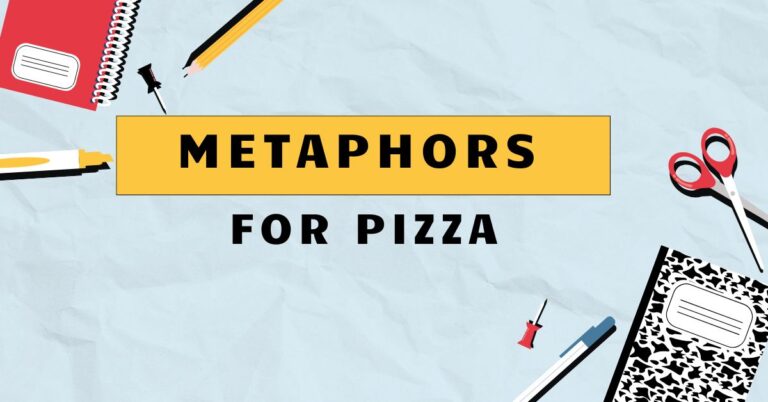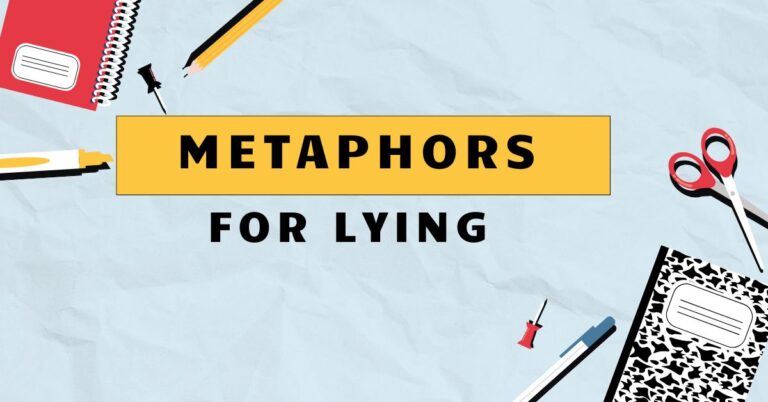33 Autumn Metaphors: A Deep Dive into Seasonal Figurative Language
Autumn, a season of change and transition, often inspires rich and evocative language. Understanding metaphors related to autumn not only enhances our appreciation of literature and poetry but also deepens our understanding of figurative language itself.
This article explores the various types and uses of autumn metaphors, offering a comprehensive guide for English language learners and enthusiasts alike. Whether you’re a student, teacher, or simply someone who loves language, this guide will provide you with the knowledge and tools to effectively recognize, analyze, and use autumn metaphors in your own writing and speech.
Table of Contents
- Introduction
- Definition of Metaphor
- Structural Breakdown
- Types and Categories of Autumn Metaphors
- Examples of Autumn Metaphors
- Usage Rules
- Common Mistakes
- Practice Exercises
- Advanced Topics
- FAQ
- Conclusion
Definition of Metaphor
What is a Metaphor?
A metaphor is a figure of speech that directly compares two unrelated things. Unlike a simile, which uses “like” or “as” to make a comparison, a metaphor states that one thingisanother.
This comparison is not literal; instead, it’s meant to reveal a shared quality or characteristic, creating a deeper understanding or a more vivid image in the reader’s mind. Metaphors are powerful tools for writers and speakers, adding layers of meaning and emotional resonance to their language.
They help us see the world in new ways by connecting seemingly disparate concepts.
Classification of Metaphors
Metaphors can be classified in several ways based on their structure and function. Explicit metaphors directly state the comparison (e.g., “He is a lion in battle”). Implicit metaphors, on the other hand, suggest the comparison without explicitly stating it (e.g., “He roared his disapproval,” implying he is like a lion). Conceptual metaphors are underlying systems of thought that shape how we understand abstract concepts (e.g., “argument is war,” where we talk about defending our position, attacking arguments, etc.). Understanding these classifications can help you identify and analyze metaphors more effectively.
Function of Metaphors
Metaphors serve several important functions in language. They cansimplify complex ideasby relating them to something familiar.
They canevoke emotionsby creating vivid imagery and associations. They canpersuade or influenceby framing an issue in a particular light.
And they canadd beauty and creativityto language, making it more engaging and memorable. The specific function of a metaphor depends on the context in which it is used and the intention of the speaker or writer.
Metaphors in the Context of Autumn
Autumn, with its characteristic changes in color, temperature, and daylight, is a rich source of metaphorical inspiration. Common autumn metaphors often relate to themes of aging, decline, transition, harvest, and beauty.
For example, autumn might be used to represent the later stages of life, the end of a cycle, or a time of reflection and preparation. The vibrant colors of autumn leaves can be metaphors for fleeting beauty, while the falling leaves can symbolize loss or the passing of time.
Understanding these common associations is crucial for interpreting and using autumn metaphors effectively.
Structural Breakdown
Tenor and Vehicle
In metaphor analysis, thetenoris the subject being described, and thevehicleis the object or concept used to describe it. For instance, in the metaphor “Autumn is the sunset of the year,” “autumn” is the tenor, and “sunset” is the vehicle.
The vehicle carries the metaphorical meaning and transfers its attributes to the tenor. Understanding the relationship between the tenor and vehicle is essential for grasping the full meaning and impact of a metaphor.
It allows us to see how the qualities of the vehicle are being attributed to the tenor, creating a new understanding of the subject.
Implied Metaphors
An implied metaphor does not explicitly state the comparison between the tenor and the vehicle. Instead, it suggests the comparison through subtle language and imagery.
For example, instead of saying “He is a fox,” an implied metaphor might say “He nimbly navigated the political landscape.” The comparison to a fox is implied through the word “nimbly,” suggesting cunning and agility. Implied metaphors require the reader to make the connection between the tenor and vehicle, adding a layer of complexity and engagement to the text.
They often create a more subtle and nuanced effect than explicit metaphors.
Extended Metaphors
An extended metaphor is a metaphor that is developed over several lines or throughout an entire work. It builds upon the initial comparison, exploring various aspects of the relationship between the tenor and the vehicle.
For example, a poem might use autumn as an extended metaphor for aging, developing the comparison through images of falling leaves, fading colors, and the approaching winter. Extended metaphors create a richer and more complex understanding of the subject, allowing the writer to explore its nuances and implications in greater detail.
They can add depth and resonance to a piece of writing, making it more memorable and impactful.
Types and Categories of Autumn Metaphors
Autumn as Aging and Death
One of the most common metaphorical associations of autumn is with aging and death. The withering of leaves, the shortening of days, and the cooling temperatures all evoke a sense of decline and mortality.
In this context, autumn can represent the later stages of life, a time of reflection on the past, and an acceptance of the inevitable end. Phrases like “the autumn of his years” or “the twilight of his life” are common examples of this type of metaphor.
The somber and melancholic atmosphere of autumn often reinforces these themes of aging and loss.
Autumn as Transition and Change
Autumn also serves as a powerful metaphor for transition and change. It is a season of shifting landscapes, as trees transform from vibrant green to fiery red, orange, and yellow.
This process of change can represent personal growth, new beginnings, or the acceptance of life’s inevitable transitions. The act of letting go of the old to make way for the new is a central theme in this type of metaphor.
Autumn can symbolize a period of preparation for the future, a time to reflect on the past, and an embrace of the present moment.
Autumn as Harvest and Abundance
While autumn is often associated with decline, it is also a time of harvest and abundance. The fruits of labor are reaped, and the bounty of the earth is celebrated.
In this context, autumn can represent the rewards of hard work, the fulfillment of goals, and the appreciation of life’s blessings. Metaphors of harvest often evoke a sense of gratitude and satisfaction, highlighting the positive aspects of the season.
Images of overflowing baskets, golden fields, and communal feasts are common in this type of metaphor.
Autumn as Beauty and Melancholy
Autumn is a season of striking beauty, with its vibrant colors and dramatic landscapes. However, this beauty is often tinged with a sense of melancholy, knowing that it is fleeting and will soon fade away.
This combination of beauty and sadness makes autumn a powerful metaphor for the bittersweet nature of life. It can represent the appreciation of the present moment, the acceptance of impermanence, and the recognition of the beauty in decay.
The poignant beauty of autumn often inspires reflection on the passage of time and the preciousness of life.
Examples of Autumn Metaphors
Here are some examples of autumn metaphors, categorized by their thematic focus. Each table provides a range of examples to illustrate the different ways in which autumn can be used metaphorically.
Examples: Autumn as Aging and Decline
The following table shows examples of how Autumn is used as a metaphor for aging and decline. Each example illustrates how the characteristics of autumn, such as the withering of leaves and the shortening of days, can be used to represent the later stages of life and the process of aging.
| Metaphor | Explanation |
|---|---|
| His career was in its autumn. | His career was nearing its end, past its peak. |
| She was in the autumn of her years. | She was in the later stages of her life. |
| The autumn of the empire signaled its decline. | The empire was weakening and nearing its end. |
| His health entered its autumn phase. | His health was deteriorating. |
| Their love story reached its autumn chapter. | Their love was fading. |
| The project was in its autumn stages. | The project was nearing completion and decline. |
| His energy was waning, like the autumn sun. | His energy was decreasing. |
| The old house stood in its autumn glory, weathered and worn. | The house, like an old person, showed signs of age. |
| The artist’s creativity was in its autumn bloom, a final burst of brilliance. | A final surge of creativity before the end. |
| The athlete’s performance mirrored an autumn leaf, slowly descending. | The athlete’s performance was declining. |
| The politician’s influence was in its autumn season. | The politician’s influence was diminishing. |
| His memory was fading, like an autumn sunset. | His memory was becoming weaker. |
| Her beauty was in its autumn glow, still radiant but fading. | Her beauty was still present but declining. |
| The company’s profits entered their autumn decline. | The company’s profits were decreasing. |
| His spirit was in its autumn quietness, reflective and serene. | His spirit was calm and reflective in old age. |
| The old tree stood in its autumn solitude, bare and exposed. | The tree, like an old person, was alone and vulnerable. |
| The nation’s power was in its autumn sunset, nearing its end. | The nation’s power was declining. |
| The garden’s vibrancy was in its autumn slumber. | The garden’s vibrancy was fading. |
| Her voice was in its autumn whisper, soft and gentle. | Her voice was weak and soft due to age. |
| The era’s influence was in its autumn twilight. | The era’s influence was coming to an end. |
| His reign was in its autumn years, filled with reflection. | His reign was nearing its end, marked by contemplation. |
| The city’s glory was in its autumn decay, beautiful but fading. | The city’s glory was declining with age. |
Examples: Autumn as Transition and Change
The following table provides examples of Autumn as a metaphor for transition and change. Each example illustrates how the changes that occur during autumn, such as the changing colors of leaves and the cooling temperatures, can be used to represent periods of transition and change in life or other contexts.
| Metaphor | Explanation |
|---|---|
| Autumn was a bridge to a new chapter. | Autumn represented a transition to a new phase of life. |
| Her life was an autumn landscape, constantly changing. | Her life was full of transitions and transformations. |
| The company was in its autumn restructuring. | The company was undergoing significant changes. |
| Their relationship entered its autumn phase of re-evaluation. | Their relationship was undergoing a period of change and assessment. |
| The political climate was in its autumn shift. | The political climate was changing significantly. |
| The project was in its autumn stage of adaptation. | The project was adapting to new circumstances. |
| His career was going through an autumn transformation. | His career was undergoing significant changes. |
| The city was experiencing its autumn renewal, rebuilding and revitalizing. | The city was undergoing a period of revitalization and change. |
| The artist’s style entered its autumn evolution, experimenting with new forms. | The artist’s style was evolving and changing. |
| The organization was in its autumn metamorphosis, adapting to survive. | The organization was undergoing a significant transformation. |
| The market was in its autumn flux, unpredictable and volatile. | The market was undergoing a period of change and instability. |
| His mindset was in its autumn evolution, embracing new perspectives. | His mindset was evolving and changing. |
| Her perspective was in its autumn shift. | Her perspective was changing. |
| The strategy was in its autumn transition. | The strategy was undergoing a period of change. |
| His approach was in its autumn adaptation. | His approach was adapting to new circumstances. |
| The system was in its autumn revision. | The system was undergoing a period of revision. |
| The process was in its autumn reformation. | The process was undergoing a period of reformation. |
| The team was in its autumn realignment. | The team was undergoing a period of realignment. |
| Her routine was in its autumn alteration. | Her routine was undergoing a period of alteration. |
| The plan was in its autumn modification. | The plan was undergoing a period of modification. |
| His habits were in their autumn turnaround. | His habits were undergoing a significant change. |
| The project’s direction was in its autumn redirection. | The project’s direction was changing. |
Examples: Autumn as Harvest and Abundance
The following table provides examples of Autumn as a metaphor for harvest and abundance. Each example illustrates how the qualities of autumn, such as the gathering of crops and the sense of plenty, can be used to represent the rewards of hard work and the appreciation of life’s blessings.
| Metaphor | Explanation |
|---|---|
| Autumn was the harvest of their efforts. | Autumn represented the rewards of their hard work. |
| Her career was in its autumn bounty. | Her career was at its most rewarding. |
| The project reached its autumn yield. | The project produced significant results. |
| Their marriage entered its autumn richness. | Their marriage was at its most fulfilling. |
| The community enjoyed its autumn prosperity. | The community was thriving and prosperous. |
| His life was in its autumn harvest of experiences. | His life was full of rewarding experiences. |
| The company reaped its autumn profits. | The company earned significant profits. |
| The garden flourished in its autumn abundance, bearing fruit and flowers. | The garden was thriving and producing plenty. |
| The artist celebrated his autumn fruition, his works gaining recognition. | The artist’s work was gaining recognition and success. |
| The team enjoyed its autumn triumph, their efforts culminating in victory. | The team’s efforts resulted in a significant victory. |
| The nation celebrated its autumn affluence, a time of economic growth. | The nation was experiencing economic growth and prosperity. |
| His spirit was in its autumn fullness, content and fulfilled. | His spirit was content and fulfilled. |
| Her creativity was in its autumn overflow. | Her creativity was abundant and overflowing. |
| The partnership reached its autumn dividend. | The partnership yielded significant rewards. |
| His investments saw their autumn gains. | His investments yielded significant profits. |
| The research produced its autumn findings. | The research yielded significant discoveries. |
| The collaboration resulted in its autumn deliverables. | The collaboration produced significant results and outcomes. |
| The campaign achieved its autumn impact. | The campaign had a significant impact. |
| Her efforts culminated in their autumn success. | Her efforts resulted in significant success. |
| The program achieved its autumn outcomes. | The program achieved its intended outcomes. |
| His contributions led to their autumn rewards. | His contributions resulted in significant rewards. |
| The strategy yielded its autumn benefits. | The strategy yielded significant benefits. |
Examples: Autumn as Beauty and Melancholy
The following table provides examples of Autumn as a metaphor for beauty and melancholy. Each example illustrates how the unique combination of vibrant colors and a sense of impending decline can be used to represent the bittersweet nature of life and the appreciation of fleeting beauty.
| Metaphor | Explanation |
|---|---|
| Autumn was a bittersweet symphony of colors. | Autumn represented a beautiful but melancholic scene. |
| Her smile was like an autumn sunset, radiant but fleeting. | Her smile was beautiful but temporary. |
| The landscape was in its autumn poignancy. | The landscape was beautiful but tinged with sadness. |
| Their love was an autumn romance, beautiful but destined to fade. | Their love was beautiful but not meant to last. |
| The moment was an autumn reverie, beautiful but ephemeral. | The moment was beautiful but fleeting. |
| His memory was an autumn tapestry, rich in color but fading with time. | His memory was beautiful but fading. |
| The song was an autumn elegy, beautiful but mournful. | The song was beautiful but sad. |
| The garden glowed in its autumn splendor, a vibrant farewell. | The garden was beautifully vibrant before its decline. |
| The artist captured the autumn lament, a beauty tinged with sorrow. | The artist conveyed the beauty and sadness of autumn. |
| The scene evoked an autumn nostalgia, a longing for what was. | The scene evoked a longing for the past. |
| The atmosphere held an autumn wistfulness, a gentle melancholy. | The atmosphere was gently melancholic. |
| Her spirit was in its autumn serenity, a peaceful acceptance. | Her spirit was peaceful and accepting. |
| The moment held an autumn grace. | The moment was beautifully graceful. |
| The memory evoked an autumn tenderness. | The memory evoked a feeling of tender sadness. |
| The scene radiated an autumn charm. | The scene was beautifully charming. |
| The song carried an autumn resonance. | The song had a beautiful and melancholic quality. |
| The painting captured an autumn allure. | The painting captured the beautiful allure of autumn. |
| The poem expressed an autumn sentiment. | The poem expressed a beautiful and melancholic sentiment. |
| Her presence radiated an autumn warmth. | Her presence radiated a beautiful and comforting warmth. |
| The event held an autumn enchantment. | The event was beautifully enchanting. |
| His words carried an autumn wisdom. | His words carried a beautiful and profound wisdom. |
| The experience evoked an autumn reflection. | The experience evoked a beautiful and thoughtful reflection. |
Examples: Mixed Autumn Metaphors
The following table presents examples of mixed autumn metaphors, where different aspects of autumn are combined to create a more complex and nuanced metaphorical meaning. These examples illustrate how the themes of aging, transition, harvest, beauty, and melancholy can be interwoven to create richer and more evocative imagery.
| Metaphor | Explanation |
|---|---|
| Autumn was the season of their golden years, a harvest of memories tinged with melancholy. | The later years of their lives were filled with rewarding memories, but also a sense of sadness. |
| Her life was an autumn landscape, a transition from vibrant summer to serene but fading beauty. | Her life was undergoing a transition from a lively phase to a more peaceful but less vibrant one. |
| The project entered its autumn phase, a time of reaping rewards and preparing for winter’s challenges. | The project was at a stage of achieving its goals and preparing for future difficulties. |
| Their love was an autumn sonnet, a blend of passionate beauty and gentle sorrow. | Their love was a beautiful but bittersweet experience. |
| The community celebrated its autumn festival, a harvest of gratitude and a farewell to summer’s warmth. | The community celebrated its blessings while acknowledging the end of a season. |
| His career was an autumn tapestry, woven with threads of success, reflection, and impending change. | His career was a complex mix of achievements, contemplation, and upcoming transitions. |
| The company embraced its autumn evolution, adapting to new markets while cherishing past accomplishments. | The company was changing to meet new challenges while appreciating its past successes. |
| The old house stood in its autumn glory, a testament to time and a reminder of life’s fleeting beauty. | The house was a beautiful symbol of the past and the impermanence of life. |
| The artist painted an autumn elegy, capturing the beauty of decay and the promise of renewal. | The artist conveyed the beauty of decline and the hope for future rebirth. |
| The team reflected on its autumn campaign, celebrating victories and learning from setbacks. | The team assessed its achievements and failures from the past campaign. |
| The nation entered its autumn era, a time of reflection, adaptation, and preparation. | The nation was undergoing a period of introspection, change, and planning for the future. |
| Her spirit embraced its autumn tranquility, a peaceful acceptance of life’s transitions and a gratitude for its blessings. | Her spirit was calm and content, embracing life’s changes and appreciating its gifts. |
| The event was an autumn spectacle, a display of vibrant colors and nostalgic reflections. | The event was a beautiful showcase of the season’s beauty and a reminder of the past. |
| The memory was an autumn reverie, a blend of vivid images and gentle melancholy. | The memory was a beautiful but slightly sad recollection. |
| The song was an autumn ballad, a harmonious blend of joy and sorrow. | The song was a beautiful and emotional expression of mixed feelings. |
| The painting captured an autumn essence, a fusion of vibrant hues and serene contemplation. | The painting conveyed the beauty and peacefulness of autumn. |
| The poem expressed an autumn sentiment, a mixture of gratitude, acceptance, and gentle longing. | The poem conveyed a complex emotion of appreciation, resignation, and longing. |
| Her presence radiated an autumn aura, a combination of warmth, wisdom, and serene melancholy. | Her presence exuded a comforting and wise but slightly sad atmosphere. |
| The experience evoked an autumn nostalgia, a longing for the past coupled with an appreciation for the present. | The experience evoked a bittersweet feeling of missing the past while appreciating the present. |
| The project represented an autumn outcome, a culmination of efforts and a preparation for future endeavors. | The project was a result of past efforts and a stepping stone for future projects. |
| His words carried an autumn resonance, a blend of profound insight and gentle acceptance. | His words conveyed a deep understanding and a peaceful resignation. |
| The strategy yielded an autumn reward, a mixture of tangible success and intangible fulfillment. | The strategy resulted in both material achievements and personal satisfaction. |
Usage Rules
Consistency in Metaphorical Language
Maintain consistency in your metaphorical language. Once you establish a particular metaphor, avoid introducing conflicting or contradictory images.
Shifting metaphors can confuse the reader and weaken the impact of your writing. For instance, if you’re using autumn to represent aging, stick with imagery related to decline and transition, rather than introducing images of growth or renewal.
Appropriateness of Metaphors
Ensure that your metaphors are appropriate for your audience and the context of your writing. A metaphor that is too obscure or complex may not be understood by your readers.
Similarly, a metaphor that is insensitive or offensive may alienate your audience. Consider the cultural background, knowledge level, and emotional state of your readers when choosing your metaphors.
Avoiding Clichés
Avoid using clichés or overused metaphors. These metaphors have lost their original impact and can make your writing sound stale and unoriginal.
Instead, strive to create fresh and innovative metaphors that will capture the reader’s attention and add depth to your writing. For example, instead of saying “time flies,” try a more original metaphor for the passage of time.
Common Mistakes
Mixed Metaphors
A mixed metaphor combines two or more incompatible metaphors, creating a nonsensical or humorous effect. For example, “We need to nip it in the bud before it snowballs” combines the metaphor of a plant being nipped with the metaphor of a snowball growing.
Avoid mixed metaphors by carefully considering the consistency and coherence of your metaphorical language.
Incorrect: The project is a marathon, not a sprint, but we need to hit the ground running.
Correct: The project is a marathon, not a sprint, so we need to pace ourselves.
Dead Metaphors
A dead metaphor is a metaphor that has become so commonplace that it is no longer recognized as a figure of speech. Examples include “the leg of a table” or “the heart of the matter.” While dead metaphors are generally acceptable in everyday language, they should be used sparingly in creative writing, as they lack the impact of fresh and original metaphors.
Consider reviving a dead metaphor by adding a new twist or using it in an unexpected context.
Overuse of Metaphors
While metaphors can enhance your writing, overuse can make it sound contrived and artificial. Use metaphors sparingly and only when they add significant meaning or impact.
Too many metaphors can overwhelm the reader and distract from your message. Focus on using a few well-chosen metaphors that effectively convey your ideas.
Practice Exercises
Exercise 1: Identifying Metaphors
Identify the metaphors in the following sentences and explain what is being compared.
| Sentence | Answer |
|---|---|
| The autumn of his life was filled with quiet reflection. | Metaphor: “Autumn of his life.” Comparison: Life to autumn, suggesting old age. |
| Her words were falling leaves, scattering across the room. | Metaphor: “Words were falling leaves.” Comparison: Words to leaves, suggesting they are fleeting and numerous. |
| The project was a harvest of their combined efforts. | Metaphor: “Project was a harvest.” Comparison: Project to harvest, suggesting the rewards of hard work. |
| His anger was a fiery autumn sunset, beautiful but destructive. | Metaphor: “Anger was a fiery autumn sunset.” Comparison: Anger to a sunset, suggesting intensity and beauty with a destructive edge. |
| The city was an autumn painting, a blend of vibrant colors and subtle decay. | Metaphor: “City was an autumn painting.” Comparison: City to a painting, suggesting a visually striking but also decaying scene. |
| Their partnership was an autumn bloom, a final burst of energy. | Metaphor: “Partnership was an autumn bloom.” Comparison: Partnership to an autumn bloom, suggesting a final surge of energy. |
| The political climate was an autumn storm, turbulent and unpredictable. | Metaphor: “Political climate was an autumn storm.” Comparison: Climate to a storm, suggesting instability and turbulence. |
| Her voice was an autumn whisper, soft and melancholic. | Metaphor: “Voice was an autumn whisper.” Comparison: Voice to a whisper, suggesting softness and sadness. |
| The decision was an autumn crossroads, a pivotal moment of change. | Metaphor: “Decision was an autumn crossroads.” Comparison: Decision to crossroads, suggesting a crucial point of change. |
| His wisdom was an autumn harvest, a collection of life’s lessons. | Metaphor: “Wisdom was an autumn harvest.” Comparison: Wisdom to harvest, suggesting a collection of valuable experiences. |
Exercise 2: Creating Autumn Metaphors
Create your own autumn metaphors for the following concepts.
| Concept | Your Metaphor |
|---|---|
| Love | Love is an autumn embrace, warm and comforting as the days grow colder. |
| Regret | Regret is an autumn wind, rustling through the fallen leaves of missed opportunities. |
| Hope | Hope is an autumn seed, buried beneath the soil, promising new life in the spring. |
| Memories | Memories are autumn colors, vibrant and beautiful but fading with time. |
| Change | Change is an autumn landscape, transforming before our eyes, unpredictable yet beautiful. |
| Ambition | Ambition is an autumn harvest, the culmination of effort and the promise of abundance. |
| Resilience | Resilience is an autumn tree, shedding its leaves but standing strong against the coming winter. |
| Friendship | Friendship is an autumn bonfire, providing warmth and light as the days grow shorter. |
| Creativity | Creativity is an autumn palette, a rich blend of colors inspiring new perspectives. |
| Peace | Peace is an autumn sunset, a serene and gentle end to a long day. |
Exercise 3: Analyzing Metaphors
Analyze the following autumn metaphors, identifying the tenor, vehicle, and the qualities being transferred.
| Metaphor | Tenor | Vehicle | Qualities Transferred |
|---|---|---|---|
| His spirit was an autumn forest, full of colorful stories and quiet wisdom. | His spirit | Autumn forest | Richness, depth, beauty, wisdom, tranquility. |
| Her career was an autumn orchard, bearing the fruits of years of labor. | Her career | Autumn orchard | Productivity, reward, fulfillment, abundance. |
| The city was an autumn stage, where life’s dramas played out against a backdrop of fading beauty. | The city | Autumn stage | Drama, impermanence, beauty, transition. |
| Their love was an autumn flame, burning brightly but destined to fade with the coming winter. | Their love | Autumn flame | Passion, intensity, beauty, transience. |
| The project was an autumn garden, yielding its final harvest before the frost. | The project | Autumn garden | Completion, reward, culmination, finality. |
| Her influence was an autumn breeze, subtly shifting the leaves of public opinion. | Her influence | Autumn breeze | Subtlety, change, gentle persuasion. |
| His legacy was an autumn painting, a masterpiece of experiences and lessons. | His legacy | Autumn painting | Artistry, beauty, impact, remembrance. |
| The era was an autumn twilight, a gentle fading of past glories. | The era | Autumn twilight | Decline, serenity, reflection, nostalgia. |
| Their partnership was an autumn sunset, a beautiful end to a productive day. | Their partnership | Autumn sunset | Completion, beauty, peace, satisfaction. |
| The decision was an autumn pathway, leading to new horizons amidst falling leaves. | The decision | Autumn pathway | Transition, choice, opportunity, change. |
Advanced Topics
Symbolism in Autumn Metaphors
Autumn metaphors are often rich in symbolism, drawing upon cultural and historical associations to convey deeper meanings. The specific symbols used in autumn metaphors can vary depending on the context and the author’s intent.
For example, the color red might symbolize passion or sacrifice, while the color gold might represent wealth or wisdom. Understanding the symbolic significance of these elements can enhance your interpretation and appreciation of autumn metaphors.
Cultural Variations in Autumn Metaphors
The interpretation and use of autumn metaphors can vary across different cultures. In some cultures, autumn may be primarily associated with harvest and abundance, while in others, it may be more strongly linked to themes of aging and death.
These cultural variations reflect different values, beliefs, and historical experiences. Be aware of these differences when interpreting autumn metaphors from different cultural contexts.
Literary Analysis of Autumn Metaphors
Analyzing autumn metaphors in literature involves examining their structure, function, and symbolism within the context of the work as a whole. Consider how the metaphors contribute to the overall themes, character development, and emotional impact of the text.
Pay attention to the relationship between the tenor and vehicle, the use of implied or extended metaphors, and the cultural associations of the imagery. By conducting a thorough analysis, you can gain a deeper understanding of the author’s message and the power of figurative language.
FAQ
What is the difference between a metaphor and a simile?
A metaphor directly equates two unlike things, stating that one thing is another (e.g., “He is a lion”). A simile, on the other hand, uses “like” or “as” to make a comparison (e.g., “He is like a lion”).
How can I avoid using clichés in my writing?
To avoid clichés, try to think of fresh and original ways to express your ideas. Use vivid imagery and sensory details to create unique metaphors that will capture the reader’s attention.
What are some common themes associated with autumn metaphors?
Common themes associated with autumn metaphors include aging, decline, transition, harvest, beauty, and melancholy.
How can I improve my understanding of metaphors?
To improve your understanding of metaphors, practice identifying and analyzing them in different contexts. Read widely and pay attention to the figurative language used by skilled writers.
Experiment with creating your own metaphors to express your ideas in new and creative ways.
Why are metaphors important in writing?
Metaphors are important in writing because they add depth, richness, and emotional resonance to the text. They can help readers see the world in new ways and create a more engaging and memorable reading experience.
Conclusion
Autumn metaphors offer a rich and evocative way to explore themes of aging, transition, harvest, beauty, and melancholy. By understanding the structure, function, and symbolism of these metaphors, you can enhance your appreciation of literature and improve your own writing skills.
Whether you’re a student, teacher, or simply a language enthusiast, mastering the art of autumn metaphors will add depth and color to your communication.

